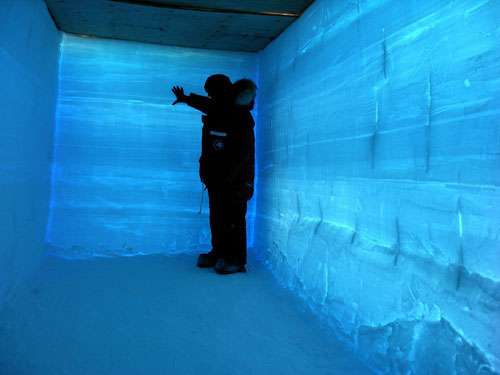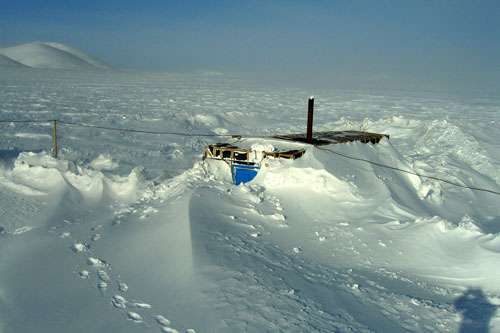National Ice Core Lab stores valuable ancient ice

It's a freezing cold day inside the National Ice Core Laboratory (NICL) in Denver, Colo., as it is every day of the year. That's because the NICL is a facility for storing and studying ice cores recovered from the polar regions of the world. It's minus 23.3 degrees Celsius (minus 10 degrees Fahrenheit) inside, so everyone is bundled up in ski parkas, insulated gloves and boots. And, saws are buzzing, as scientists from all over the U.S. are measuring and cutting pieces of precious Antarctic glacier ice to take back to their labs for research.
"I'm here to cut gas samples out of this core," says Murat Aydin, a chemist who's visiting from the University of California, Irvine.
"I'm looking at the mineralogy of the ice," says Donald Voigt, a geoscientist from Penn State.
"I'm studying the stable water isotopes that tell us about past temperature changes," adds Brad Markle, a geochemist from the University of Washington.
While their research goals vary, all the scientists are here on this day for same thing—ice cores from the WAIS Divide Ice Core project. WAIS stands for West Antarctic Ice Sheet. The WAIS Divide is a high point on the ice sheet where the ice begins to flow in different directions.
"We started this ice core project in 2005," says manager Mark Twickler. With support from the National Science Foundation (NSF), Twickler and a team of scientists, engineers and support personnel traveled to the bottom of the world to drill and bring back these ice cores, which are perfectly preserved records of the distant past.
The ice cores were taken from a giant ancient Antarctic ice sheet more than 70,000 years old. An ice sheet is a permanent layer of ice covering an extensive tract of land. The team drilled down more than two miles to retrieve the oldest pieces of ice in the sheet. The cores were carefully packed and shipped back to the U.S. and stored in a giant freezer at the NICL. The temperature in the freezer is minus 40 degrees Celsius (and Fahrenheit), and it contains more than 18,000 meters, or ten miles, worth of ice cores.
Twickler says ice core layers are like tree rings because each layer represents a year of weather. "The unique thing about polar glaciers is that each year brings another layer of snow. So, you get one year's worth of snow on top of the previous year. The layers compress, so everything that fell out of the atmosphere, including dust, salt from the ocean and volcanic ash, is preserved in the ice core," explains Twickler.
"There are times where it snows less for a couple years, and then it snows more for a few years, and by looking at the composition of the snow, we can tell what the temperatures were, how rough the oceans were around Antarctica, and even how dusty it was in Australia. We can tell whether the dust came from Australia or South America, so in that way, we know the winds were stronger and drier in one region, or the other. We can also look at the electrical properties of the ice from year to year. So, it's basically like looking at a weather report, year to year, going back in time," continues Twickler.

"The National Ice Core Lab is a world class facility that has been in operation for close to 20 years now, as well as a unique training ground for students, some of whom began as undergraduates and have now gone on to graduate school because of their experience at the lab," says Julie Palais, program manager for the Antarctic glaciology program within the NSF's Office of Polar Programs. "In addition, the facility houses one of the most unique collections of scientific samples in the world, and group tours provide a wonderful opportunity for members of the public and school children to learn about the important work being done on samples from both polar regions." Arctic as well as Antarctic samples are stored at the facility.
Some scientists study the bubbles trapped within the cores—each a tiny pocket of air, frozen in time. "We can take those bubbles and measure a variety of gases that were in the atmosphere at the time the bubbles were formed," says Twickler.
The National Ice Core Laboratory is operated and maintained through an interagency agreement between NSF and the U.S. Geological Survey (USGS).
"The NICL facility provides the ice core research community with the capability to conduct examinations and measurements on ice cores, while preserving the integrity of these cores in a safeguarded, temperature-controlled environment. This is accomplished with multiple backups built into the refrigeration system and a 24/7 alarm system to alert us of any problems that occur," explains Betty Adrian, NICL acting technical director.
USGS scientist Joan Fitzpatrick is looking at WAIS Divide ice core samples to research how ice sheets respond to changing climate. In order to do that, she creates thin wafers of ice from the core and then places the wafer samples under a microscope to analyze individual ice crystals.
"If the climate is warming, is the ice sheet going to get thinner overall? Is the ice sheet going to fall apart around the edges or is it suddenly going to slide off the continent?" asks Fitzpatrick. "We really don't have a good handle on how the ice sheet as a whole will respond in a changing climate. The water that comes out of the melting ice sheets melts into the oceans and can raise sea level. This is a key issue for the public," she adds.
"These icy blasts from the past are helping researchers better understand the mechanics of climate change," says Linda Morris, education program manager for the U.S. Ice Drilling Program. "Ice cores give us this long historical record of what naturally has been occurring to the Earth's climate for hundreds of thousands of years. More recent patterns emerging from times when humans have inhabited the Earth can then be evaluated against this long term data to more meaningfully assess the impact of our behaviors on climate. It's an exciting inquiry and an important one if we are to be good stewards of our environment into the future."
Provided by National Science Foundation

















